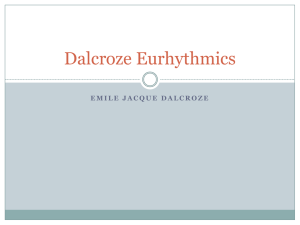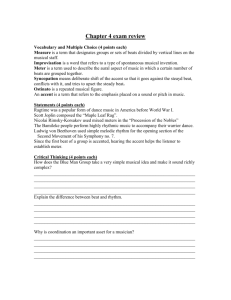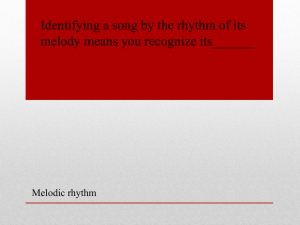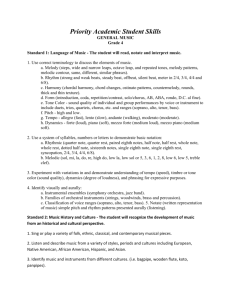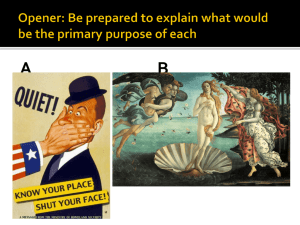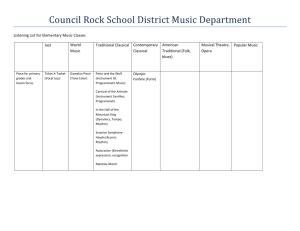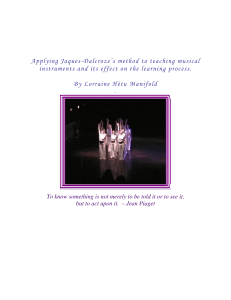americaneurhythmics.org IMPLEMENTING DALCROZE
advertisement
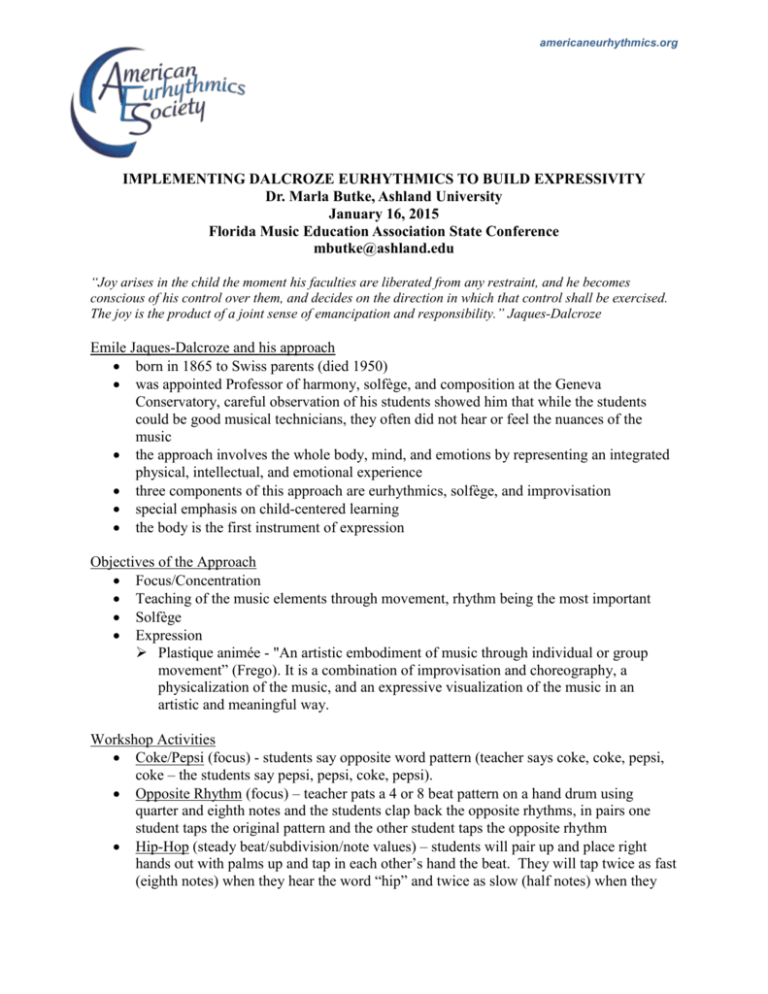
americaneurhythmics.org IMPLEMENTING DALCROZE EURHYTHMICS TO BUILD EXPRESSIVITY Dr. Marla Butke, Ashland University January 16, 2015 Florida Music Education Association State Conference mbutke@ashland.edu “Joy arises in the child the moment his faculties are liberated from any restraint, and he becomes conscious of his control over them, and decides on the direction in which that control shall be exercised. The joy is the product of a joint sense of emancipation and responsibility.” Jaques-Dalcroze Emile Jaques-Dalcroze and his approach born in 1865 to Swiss parents (died 1950) was appointed Professor of harmony, solfège, and composition at the Geneva Conservatory, careful observation of his students showed him that while the students could be good musical technicians, they often did not hear or feel the nuances of the music the approach involves the whole body, mind, and emotions by representing an integrated physical, intellectual, and emotional experience three components of this approach are eurhythmics, solfège, and improvisation special emphasis on child-centered learning the body is the first instrument of expression Objectives of the Approach Focus/Concentration Teaching of the music elements through movement, rhythm being the most important Solfège Expression Plastique animée - "An artistic embodiment of music through individual or group movement” (Frego). It is a combination of improvisation and choreography, a physicalization of the music, and an expressive visualization of the music in an artistic and meaningful way. Workshop Activities Coke/Pepsi (focus) - students say opposite word pattern (teacher says coke, coke, pepsi, coke – the students say pepsi, pepsi, coke, pepsi). Opposite Rhythm (focus) – teacher pats a 4 or 8 beat pattern on a hand drum using quarter and eighth notes and the students clap back the opposite rhythms, in pairs one student taps the original pattern and the other student taps the opposite rhythm Hip-Hop (steady beat/subdivision/note values) – students will pair up and place right hands out with palms up and tap in each other’s hand the beat. They will tap twice as fast (eighth notes) when they hear the word “hip” and twice as slow (half notes) when they americaneurhythmics.org hear the word “hop.” Students then will step to the beat and follow the same directions while the teacher plays the beat on the hand drum. Add the recording (Torelli “Concerto in D – Allegro”) and follow same procedure. Harmonic Dictation (tonic/dominant/subdominant/harmony) – teacher plays simple chord progressions on piano, have students walk forward when they hear the tonic chord, walk sideways when they hear the subdominant chord, and walk backwards when they hear the dominant chord. Melodic Rhythm/Texture – Using “Ivan Sings” by Khachaturian - students walk quarter note then half note, and conduct then in partners, tap 4 measure melodic rhythm, then have one student tap melodic rhythm and the other the beat and switch, walk melodic rhythm, clap accompaniment rhythm, in partners, one taps the melodic rhythm and the other taps the accompaniment rhythm, then switch when teacher indicates, students either walk beat, melodic rhythm, or accompaniment as teacher indicates Statues – students are in a circle, one student goes in the middle and forms an interesting body position and when the drum plays the next student in the circle joins the statue, complimenting the first person (but not touching), then continues until all students are part of the statue. Then when the teacher says flow the statue slowly moves in a flowing manner until the teacher says freeze and then it freezes. (“The Mission; Gabriel’s Oboe”). Plastique animée – Using Elgar’s Enigma Variations: “Nimrod” show phrasing, dynamics, dissonance with stretchy material individually, small group, large group __________________________________________________________________________ What is the American Eurhythmics Society? Started by Dr. David Frego, Dr. Marla Butke, and Dr. Kathy Thomsen who are all Master Teaching Artists and presently serve as the board members, the American Eurhythmics Society seeks to continue the work of Dalcroze by providing training opportunities in Eurhythmics for music educators who practice their craft in the classroom or in the private teaching studio. The AES will serve those teachers looking for meaningful ways to include movement rooted in the philosophy of Dalcroze to meet national and state education standards, and to provide authentic assessment opportunities. The AES will teach personal musicianship along with pedagogy and applications of Eurhythmics. AES Training Centers (for certification and/or professional development) University of Texas at San Antonio - June 15-19, 2015 (annually) Vandercook University, Chicago – June 29-July 3, 2015 (bi-annually) Ashland University, Columbus – June 22-26, 2015 (held annually) University of St. Thomas, Minnesota – Summer 2016 Wisconsin Center for Music Education – Summer 2015 University of Kentucky – July 23-25, 2015 (annually) Anderson University, Indianapolis – June 27-July 1, 2016 (bi-annually) University of Hawaii – Summer 2016 (bi-annually) Florida and Nevada are in the works! Check out the website at http://www.americaneurhythmics.org/ . If you become a member you will have access to lesson plans, videos of lessons, piano improvisation ideas, and plastique animée examples with children and adults, a bibliography, blogs, and an extensive recording list with concepts to be taught.
